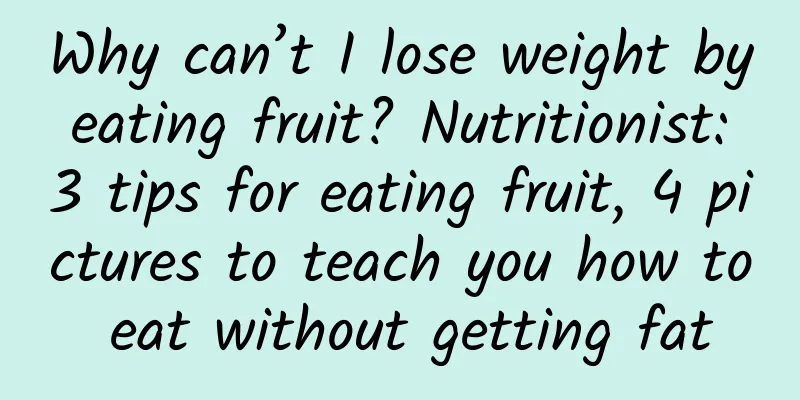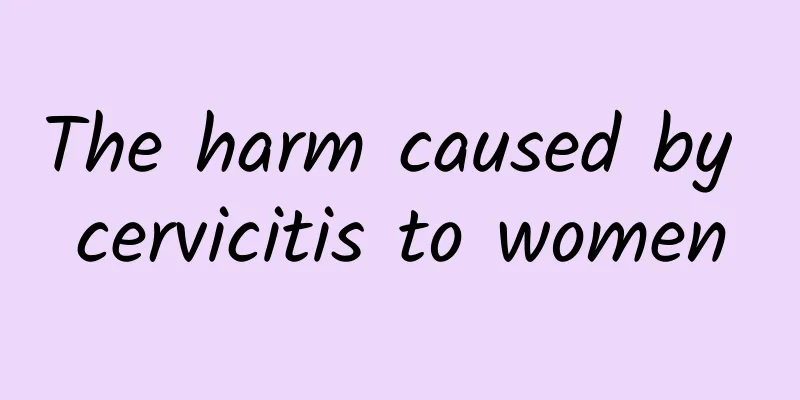Why can’t I lose weight by eating fruit? Nutritionist: 3 tips for eating fruit, 4 pictures to teach you how to eat without getting fat

|
Many girls eat only fruits for three meals a day to lose weight, but they find that they still cannot lose weight, so they accept any fruit. They eat a large piece of watermelon, a whole mango, and even small fruits like lychees and grapes at every meal. After a period of time, not only do they fail to lose weight, but their blood sugar level also increases, which is really troublesome. What exactly went wrong? Nutritionists use 4 charts to teach everyone how to eat fruits without gaining weight and still get nutritional benefits. Eat fruit to lose weight, but still can’t lose weight? Nutritionist: That’s the problem! Fruits are rich in dietary fiber, vitamins, minerals, phytochemicals, etc., so they are also recognized as representatives of nutritious foods. Nutritionist Gao Minmin wrote in her new book "Gao Minmin Teaches You How to Eat in This Way to Get the Best Nutrition, Get the Most Supplements, and Lose Weight the Fastest!" ” (published independently) mentioned that I often hear friends share that they all rely on eating fruits to lose weight, and do not eat other fried foods or processed products, but they always cannot lose weight! Why is this happening? Because they always think that fruits have no calories or very low calories, they eat fruits with every meal without moderation. I believe that many friends who are losing weight have this misconception, and as a result, they become more and more discouraged the more they lose weight. In addition to the issue of calories, you should also pay attention to the amount of fruit you eat. Many people eat a large piece of watermelon, bite a whole mango, or eat small fruits such as lychees and grapes one after another. In fact, these ways of eating are treating 10 portions of fruit as 1 portion of fruit per day. At the same time, I have also met many people who are afraid to eat fruits because they are worried that they are too sweet. They only touch fruits that are not sweet. In fact, this is a trap of fruits. It is true that different fruits have different calories depending on their sweetness, but it does not mean that fruits that do not taste sweet are low in calories. Many non-sweet fruits actually have surprisingly high calories, even higher than very sweet fruits. Surprisingly, right? Tip 1 for eating fruit: Understand the amount of "1 serving of fruit" Simply put, there are smart ways to eat fruit. So how should we eat it without gaining weight? Now, let’s learn how to create your own fruit meal! First, let’s understand how much “1 serving of fruit” is? The answer is: 1 serving of fruit = 60 calories = 15g carbohydrates. Describing it with numbers may be a little abstract. You can raise your hand and make a fist. One fist size is equal to one serving of fruit. This is usually an easier way to grasp the portion. However, if it is fruit like pineapple, watermelon, mango, papaya, etc., which are more difficult to estimate the portion, you can cut them into cubes or slices and put them into a normal rice bowl. About 80% full is one serving of fruit. The following lazy bag is the amount of fruit I grabbed for everyone. Tip 2 for eating fruit: Normal people eat 2 to 4 servings a day After understanding the amount of "1 serving of fruit", some people must be curious about how much they can eat in a day? I suggest that normal people can eat 2 to 4 servings a day; 2 to 3 servings are recommended for diabetics or people who need to control blood sugar; people with high triglycerides are recommended to eat only 2 servings of fruit a day; people with high blood pressure can eat 4 servings a day, and those who must control blood sugar on a regular basis are recommended to eat 2 hours after a meal. Tip 3 for eating fruit: Eat at different times Many people ask me: "Nutritionist, should we eat fruit before or after meals?" I guess everyone thinks that the best time to eat fruit is after meals, right? In fact, there are different time periods for eating fruits. You should eat them at different times according to each person's different conditions, and choose the right fruits to consume. Now let's see which type of person you are? And when is the right time to eat? [The five major groups eat fruits this way] Normal healthy people You can eat it whenever you think of it, or you can eat one serving of fruit between meals every day, and try to choose fresh seasonal fruits. The amount for one time is the size of one fist as mentioned above, or 80% full of a bowl, and eat it 2 to 4 times a day. When eating a big meal Nutritionist Gao Minmin recommends that you can consume fruits containing digestive enzymes after meals to help improve digestion! Pineapples, for example, are rich in dietary fiber and bromelain, which help break down proteins. Eating them in moderation after meals can promote digestion and reduce bloating. The water-insoluble dietary fiber in them can also help absorb water in the intestines. In addition, the papain in papaya, also known as papain, can help digest food. Kiwi fruit also contains enzymes that break down protein, which can promote protein digestion and prevent stomach upset. These fruits can promote gastrointestinal motility, reduce the occurrence of constipation, and are very suitable for eating after meals. People with high blood sugar It is recommended that people with high blood sugar eat low-GI, high-fiber fruits between meals to avoid large fluctuations in blood sugar and increase satiety. Recommended fruits include guava, apple, and cherry tomatoes. Guava is a fruit with a very high vitamin C content, which can help lower blood pressure and blood lipids; the dietary fiber and polyphenols in apples can help inhibit the rise in blood sugar; and the lycopene in cherry tomatoes can help the body resist oxidation and protect the cardiovascular system. Sports People After exercise, it is recommended that people eat medium- and high-GI fruits within 1 hour to help replenish physical strength and energy. You can also replace sports drinks with fruits, because fruits contain the most natural sugar and water, and they will produce a certain sense of fullness, so you will not eat too much at the main meal. It is recommended to eat bananas, watermelons and grapes after exercise. People often choose to eat bananas after exercise because bananas can quickly replenish glucose in the body and help repair muscles. The magnesium and potassium in bananas can also prevent cramps and other conditions. You can also eat watermelon after exercise, because a lot of sweating requires more water. Watermelon is rich in water, which can relieve heat and thirst while also replenishing sugar, helping to increase and stabilize blood sugar. In addition, the citrulline in watermelon can also promote metabolism and relieve muscle soreness. It is recommended to rest for half an hour after exercise before taking it. The anthocyanins in grapes can help relax blood vessel muscles and reduce joint swelling. People with bad stomach It is recommended that people with poor stomachs avoid eating sour fruits and fruits containing protease on an empty stomach to avoid stimulating gastric acid secretion. Pineapples, kiwis, and lemons are such fruits. You can eat apples, papayas, bananas, cherries, etc. instead. Summer fruit calorie ranking Let’s take a look at this summer fruit calorie ranking. How many calories are there per 100g? 1. Custard Apple: 99 kcal 2. Banana: 82 kcal 3. Longan: 70kcal 4. Lychee: 67 kcal 5. Grapes: 63 kcal 6. Passion fruit: 58kcal 7. Pineapple: 51 kcal 8. Mango: 48 kcal 9. Dragon fruit: 48 kcal 10. Pear: 39 kcal Have you discovered it? Although watermelon tastes very sweet, its calories per 100g are not as high as that of sugar apple! In fact, the key factor that affects the sweetness of fruit taste is the ratio of the three types of sugars in the fruit: fructose, sucrose, and glucose. "Fructose, sucrose, and glucose" all have 4 calories per gram, but fructose tastes the sweetest, sucrose is the second sweetest, and glucose tastes the least sweet. So a fruit that tastes very sweet does not necessarily have the highest calories. It should be said that its sugar ratio is very pleasing. Fruit Calorie Ranking Next, what is the ranking of calories per 100g of fruits and dried fruits? The calories of common fruits are listed below for your reference. Which one is your favorite? My favorite melons are watermelon and cantaloupe! Super high heat 1. Dried mango 371kcal 2. Raisins 341 kcal 3. Dried longan 277 kcal 4. Black dates 230 kcal 5. Durian 136 kcal 6. Banana 124 kcal 7. Custard Apple 104 kcal High in calories 1. Banana 85 kcal 2. Cherries 75 kcal 3. Longan 73 kcal 4. Passion fruit 66 kcal 5. Avocado 65 kcal 6. Lychee 65 kcal 7. Green grapes 57 kcal 8. Pineapple 53 kcal Medium Calories 1. Kiwi fruit 59 kcal 2. Sweet persimmon 57 kcal 3. Pear 53 kcal 4. Pitaya 51 kcal 5. Apple: 51 kcal 6. Mango 50 kcal 7. Sanji 47 kcal 8. Peaches 44 kcal 9. Dates 43 kcal Low in calories 1. Strawberry 39 kcal 2. Cantaloupe 39 kcal 3. Papaya 38 kcal 4. Guava 38 kcal 5. Wax Apple 35 kcal 6. Tomato 35 kcal 7. Pomelo 33 kcal 8. Lemon 33 kcal 9. Star fruit 32 kcal 10. Yellow-fleshed watermelon 29 kcal Don’t eat dried fruits as fruit In addition, friends who like to eat dried fruits should pay special attention. In fact, it is not recommended to eat dried fruits as fruits! Because dried fruits are usually made with sugar, the calories and sugar content will naturally increase. In addition, important water-soluble nutrients and water are easily lost. It is recommended to eat more fresh fruits to get more adequate vitamins, phytochemicals, etc. If you really want to eat dried fruits, just bake them yourself! At least there is no added sugar and dietary fiber will not be lost. Nutritionist Gao Minmin finally reminds friends who have nutritional imbalances that they can replace high-calorie afternoon tea snacks or hand-shaken drinks with fruits! The key to eating fruit is to master the "amount of intake". Most people just need to remember to eat 2 fist-sized portions or 80% full of normal bowls of fruit every day. If you eat too much, no matter how sweet the fruit is, it will still make you fat and affect blood sugar and blood lipids. |
Recommend
What medicine can cure endometrial tuberculosis?
Endometrial tuberculosis is a disease that can af...
Can irregular menstruation cause spots on the face?
Menstruation, also known as menstruation, is one ...
What is pregnancy complicated with ovarian cysts?
Pregnancy complicated with ovarian cyst refers to...
Bacterial vaginosis medication guide
As we all know, gynecological diseases are diffic...
What can I eat if I have hyperprolactinemia?
What foods can be eaten to regulate hyperprolacti...
Experts remind: It is very important for female friends to prevent cervical erosion
In recent years, with the change of people's ...
See what symptoms and hazards of various vaginitis
Vaginal itching is unbearable and you are restles...
Can I get pregnant with a thin endometrium?
The uterus plays an important role in women's...
How to treat habitual miscarriage? There are 6 treatments
In fact, pregnant women have a higher chance of h...
What are the dietary precautions for women with cervical erosion? Three dietary precautions for patients with cervical erosion
The emergence of cervical erosion has seriously d...
How much do you know about the symptoms caused by ovarian cysts?
Ovarian cysts are a disease that has no obvious s...
Beijing Gynecological Hospital
A healthy body is the capital of revolution, espe...
What foods are good for pelvic inflammatory disease? Scientific diet conditioning
In addition to active treatment, those who unfort...
The nemesis of potbelly! Ginger coffee and black tea to eliminate fat
For women who love beauty, the most difficult par...
What are the common symptoms of pelvic inflammatory disease?
Pelvic inflammatory disease is a common gynecolog...









